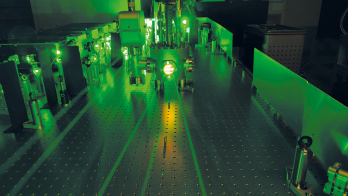After 15 years in physics, Harvard University’s 160 MeV machine was converted into a cancer therapy centre. Having treated over 7500 patients in the ensuing 34 years, it is being phased out after two distinguished careers.
3 June 1999 will mark 50 years since the first beam was accelerated at the Harvard Cyclotron Laboratory (HCL). Originally built for physics research, the lab switched direction and went on to play a dominant role in the development and application of charged-particle radiation therapy.

The first Harvard cyclotron, built in 1937, was taken to Los Alamos for the Manhattan Project in 1943 and never returned. Planning for the present lab began in 1946 with the involvement of Kenneth Bainbridge, Robert R Wilson, J Curry Street and Edward M Purcell as well as R W Hickman, then Director of the Physics Laboratory. The US Office of Naval Research (ONR) funded the machine while Harvard paid for the building. Figure 1 shows HCL Deputy Director Lee Davenport and Norman Ramsey, Chairman/Director of the Physics Department’s Cyclotron Committee, with the machine just before its dedication on 15 June 1949. Harry Truman was starting his second term as US President, television and FM radio were gaining in popularity and commercial transistors were still a few years away.
In the synchrocyclotron boom of the 1940s and 50s, the Harvard machine was for a time the third largest in the USA. The 14 foot diameter magnet coils were shipped edgeways from General Electric in western Massachusetts using one of the two deepest flat well railroad cars in the country. The lowest bridge on this route dictated the size of the cyclotron!
Initially the proton energy was 95 MeV, with only weak (scattered) external proton and neutron beams. Many experiments used the internal beam. The physics programme was a mix of proton-nucleus and nucleon-nucleon experiments at what we now call medium energy: much greater than nuclear binding, but below particle production. Counter, emulsion and activation techniques were used. Experimenters included Norman Ramsey, Ralph Waniek, Walter Selove, Jim Meadows and Karl Strauch.
Throughout the physics period there was a host of graduate students, many later achieving recognition in high energy and other fields of physics. Eventually HCL produced some 30 PhD theses and countless articles. William M Preston was named Director in 1953. In the same year Andreas M Koehler arrived, and eventually became de facto Technical Director and chief troubleshooter.
A young British physicist, Richard Wilson, arrived in 1955 to apply the new “regenerative extraction”. HCL emerged from that one-year upgrade the only substantial shutdown in 50 years with 160 MeV protons and external polarized and unpolarized proton beams of respectable intensity.
The physics programme grew steadily, peaking around 1958 with 38 personnel. The annual report for that year describes a new ion source (Koehler), quasi-elastic proton-proton collisions and inelastic proton cross-sections (Strauch et al. ), various polarized proton scattering experiments (Cormack, Palmieri, Ramsey and Wilson et al. ), proton triple scattering (Wilson et al. ) and protondeuteron scattering (Wilson et al. ). Eventually a quasi-monoenergetic neutron beam was built (Measday). The last major physics upgrade was a stochastic extraction system to improve the beam duty factor, leading to the first observation of proton proton bremsstrahlung in 1965 (Gottschalk et al.).







